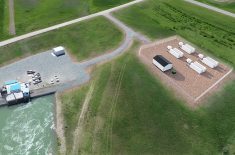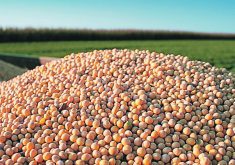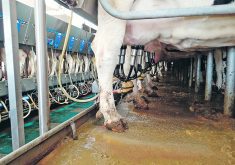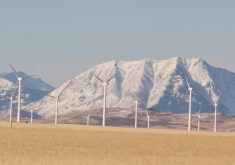According to the solar industry, many inquiries about projects are from producers interested in reducing their energy bills
Farmers and renewable energy developers can work together to transform how agriculture is practised in Alberta, said a solar power advocate.
Solar Alberta has made recommendations on where to place solar projects in the province, said executive director Heather MacKenzie. One of the goals of the non-profit organization is to educate the public about solar development.
“And so, by and large, we recommend preserving some of the best quality land, of course, for food security purposes. We also say, however, if developing a full array on farmland, please consider co-locating solar with crops or livestock.”
Read Also

Government, industry seek canola tariff resolution
Governments and industry continue to discuss how best to deal with Chinese tariffs on Canadian agricultural products, particularly canola.
Sheep and some types of plants can be raised under solar arrays, although wheat or barley aren’t options because of the size of the farm equipment needed to harvest those crops, said MacKenzie.
“You don’t need to actually have this either/or conversation” about agriculture and renewable energy, she said. “It is entirely possible to do both at the same time.”
MacKenzie said many inquiries received by Solar Alberta are from producers interested in reducing their energy bills by creating electricity for their own use through small-scale micro generation on their farms.
Producers are frustrated by the lack of government incentives for solar for agriculture, along with regulations that prevent them from selling extra power to the electrical grid, she said.
“I mean, honestly, I’m not lying … the majority of calls I get is from rural Alberta.”
The province’s large-scale wind projects are helping meet Canada’s ambitious carbon emission reduction goals, said Evan Wilson, senior director for Western Canada with the Canadian Renewable Energy Association (CanREA). Thousands of megawatts of new wind projects have come online in the past few years in Alberta.
Major companies are signing contracts with wind and solar developers to meet targets for net zero energy, he added.
Asked if more outreach is needed by renewable energy companies to address the fears of rural residents about solar and wind projects, Wilson said, “I think this is obviously an important conversation for all Albertans. And I would say that here at CanREA, we’re eager to have conversations about the regulatory approach and have conversations about these issues with anyone who would like to discuss them with us.”
He said one reason wind projects are getting taller and using longer blades is that they can generate more power at less cost, reducing the cost of electricity while avoiding the carbon price under the province’s Technology Innovation and Emissions Reduction (TIER) Regulation.
Cheaper energy benefits all Albertans, including farmers and rural communities, said Wilson.
“And Alberta is home to the best wind resource in the whole country. This is really the place where we have so much opportunity to generate clean electricity because of the wind resource.”
Besides benefiting rural landowners who receive lease payments for wind and solar projects, rural municipalities now earn property taxes from such developments. This eases the burden on taxpayers including farmers.
“I would estimate we’re talking millions of dollars per year … based on the projects that have been deployed over the last three years or so,” said Wilson.
Alberta’s rural municipalities are collectively seeking an estimated $253 million in unpaid taxes owed by oil and gas companies as of Dec. 31, 2021, despite the recent upturn in the industry’s fortunes. Thousands of producers are also owed surface rights payments for having oil and gas wells on their land.
Wilson said the construction of wind projects creates about 300 jobs and solar about 200 jobs for every 100 megawatts produced. Although some opponents say renewable energy projects should be built on former industrial or brownfield sites rather than farmland, Alberta has a “very strong record of the co-location of agricultural land with wind turbines,” he said.
“You often see crops grown right up to the foundation of a wind farm. You often see animals grazing up to the foundation of a wind farm, and that is typically done with wind and with solar.”
Members of CanREA consider the expectations of farmers to use their land as they see fit, said Wilson. It ranges from the types of crops they would like to have co-located with solar arrays to how equipment is deployed, he said.
By contrast, producers have no say over oil and gas wells on their land, said Wilson.
“And I keep coming back to the fact that these are private agreements between the landowners and the developer in which you really have a landowner who has their own property rights to do what they wish with their land,” he said.
“So, I think there’s a real collaborative effort between the host landowners and the developers to ensure both parties are happy with the agreement.”


















